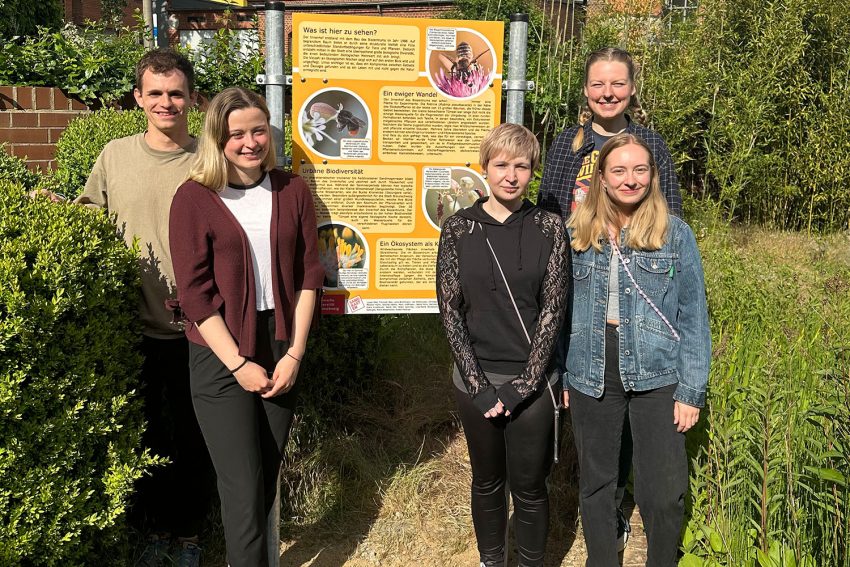An ecosystem becomes visible Interdisciplinary project shows biodiversity in the courtyard of the Biocentre
Surrounded by lots of brick walls, an ecological niche lurks in the urban area. In the courtyard of the Biocentre of Technische Universität Braunschweig, an exciting ecosystem has developed in recent years. Where flowing water experiments used to take place, kidney vetch, crown vetch and about 25 different bee species are now at home. Lucas Well, a doctoral student at the Institute of Genetics, has developed a sign together with ten students as part of the Service Learning project “Das Biotop sichtbar machen“ (Making the biotope visible), which now points out this retreat for flora and fauna.

Lucas Well, Lia Ditzhuyzen, Tabea Spengler, Lena Buchmann and Klara Knoblauch (from left to right) are part of the project team “Das Biotop sichtbar machen” (Making the biotope visible). Photo credit: Mark Winter/TU Braunschweig
Between red brick walls and remnants of former ponds, it blossoms and hums wherever you look. On a seemingly overgrown area in the inner courtyard of the Biocentre, an astonishing biodiversity has found its retreat. Several factors are responsible for the emergence of the ecosystem: On the one hand, flower mixtures were sown in the inner courtyard of the Biocentre from time to time and some plants brought back from excursions were planted, some of which were able to conquer the area. On the other hand, extensive maintenance through annual mowing creates space for new plants. A conceptual design of the area, for example as a park-like facility, was never undertaken. In addition, a water basin and an overgrown pond serve as a source of water for insects to survive in the otherwise dry courtyard.
Many biologically valuable plants have taken advantage of these ideal conditions to settle here. On the nutrient-poor dry grassland, borage plants, medicinal plants such as oregano or kidney vetch, and regionally non-native plants such as crown vetch can be found in the biotope. The abundance of plants is also accompanied by a diversity of insects living there. Plants and pollinating insects are in part firmly associated with each other. “There are bees that only fly to a certain plant. The presence of these plants in the ecosystem also creates an island in the city for specialised bee species. Here alone in the ecosystem, an expert has counted 25 different bee species,” explains Lucas Well, doctoral student at the Institute of Genetics and initiator of the project “Das Biotop sichtbar machen”.
Acceptance through visibility
In order to focus more strongly on this biodiversity in the courtyard of the Biocentre as a space worth protecting, Lucas Well offered a Service Learning course last winter semester. The aim of this course was to create an information sign pointing out the special features of the biotope. “Even spatially limited, inner-city areas can make valuable contributions to the conservation of threatened biodiversity. However, these spaces must become more visible so that they are perceived as valuable instead of overgrown,” wishes Well.
Ten Bachelor’s and Master’s students from the Biology, Biotechnology and Geoecology degree programmes worked on the project “Das Biotop sichtbar machen”. Over the course of a semester, they worked together with great commitment to acquire knowledge about the flora and fauna of the biotope, invited experts and finally designed the information board. The course not only expanded the students’ methodological and content-related expertise, but also resulted in a concrete recommendation for action for the planning of urban spaces in order to specifically enable ecosystems on smaller areas and to make existing systems more visible through signs.
The sign designed in the project is made of weather- and sun-resistant material so that it can still provide information about the biotope in a few years’ time. In addition, the data collected on biodiversity was stored in tabular form and made accessible via QR code on the display board so that it is available for further research and updates.
Learning through commitment
The project “Das Biotop sichtbar machen” was planned and implemented as part of the teaching-learning format Service Learning with the Sandbox platform, which has been SQM-funded since October 2022. The Knowledge Transfer team of the Transfer- und Kooperationshaus provides support services for service learning courses that aim to enable learning through commitment. “Service Learning” is a sub-project of the package application “tu4society – Stärkung der Transfer- und Kooperationskompetenz in Studium und Lehre“ (Strengthening Transfer and Cooperation Competence in Studies and Teaching), which is intended to enable students in the long term and sustainably to apply the knowledge acquired in their studies to real social challenges and problems and to contribute to their solution with innovative ideas.
